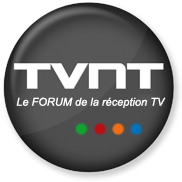un petit programme permettant de lire les fichiers pal/ntsc produits par hacktv :
http://gtrx1.selfip.net/analyze_raw.zip
NTSC — pal — secam
Re: NTSC — pal — secam
Ecouteur parisien a écrit:BAISIN a écrit:Non, je ne fais pas de SECAM Bashing, car les Russes l' utilisent encore.
Si j'en crois le WRTH 2019 la Russie est passé au tout numérique (DVB-T2) en 2018 ! Par contre il doit rester du SECAM en Ukraine et en Moldavie... mais probablement plus pour longtemps...
Daniel
Ainsi qu' en Afrique Francophone, en norme K' .
- BAISIN
- Mammouth

- Messages: 7591
- Inscription: 09 Aoû 2009 21:18
- Localisation: Grenoble
Re: NTSC — pal — secam
Mannix54 a écrit:un petit programme permettant de lire les fichiers pal/ntsc produits par hacktv :
http://gtrx1.selfip.net/analyze_raw.zip
C'est un signal SECAM crypté en SYSTER NAGRAVISION généré avec ce logiciel, c'est super
DVB-T (TNT) Chambéry 1 Dent du Chat.
DAB+ 12A La Dôle.
DAB+ 12A La Dôle.
- jeanphi73
- Hippo

- Messages: 4118
- Inscription: 27 Juin 2005 23:07
- Localisation: Rhône-Alpes
Re: NTSC — pal — secam
+1invité1 a écrit:Ben a en croire l'oscillogramme le Secam c'est plus ce que c'étaitjeanphi73 a écrit:C'est un signal SECAM
Pas de trace de préaccentuation "anticloche"
Dernière édition par marceljack le 15 Mar 2019 22:31, édité 1 fois.
Modérateur des forums tvnt.net
Installation TNT: Paris: VTU50 collective 21-60 / Royan: Lambda 9 + préampli
TV HD: Thomson FE9234B, Philips 39PFL3807, Acer AT2356,
PC: Pinnacle PCTV310i & 310e, Technaxx DVB-S3, Techgear Diversity Stick, Terratec TStick+
Installation TNT: Paris: VTU50 collective 21-60 / Royan: Lambda 9 + préampli
TV HD: Thomson FE9234B, Philips 39PFL3807, Acer AT2356,
PC: Pinnacle PCTV310i & 310e, Technaxx DVB-S3, Techgear Diversity Stick, Terratec TStick+
- marceljack
- Brigades du Tigre

- Messages: 22776
- Inscription: 06 Oct 2005 18:59
- Localisation: 75019 PARIS
Re: NTSC — pal — secam
c'est du pal, car hackTV ne gère pas encore le secam, l'auteur a essayé d'implémenter le secam, mais a abandonné à cause de la difficulté de traitement du secam en mode 100% logiciel et de mise au point des filtres pour le secam,
hackTV peut générer du pal (norme I, B et G), ntsc en clair, et peut aussi générer un signal pal syster (mais avec moins d'options que cryptimage), il peut générer aussi du videocrypt,
les options en ligne de commande de hackTV :
hackTV peut générer du pal (norme I, B et G), ntsc en clair, et peut aussi générer un signal pal syster (mais avec moins d'options que cryptimage), il peut générer aussi du videocrypt,
les options en ligne de commande de hackTV :
- Code: Tout sélectionner
$ ./hacktv --help
Usage: hacktv [options] input [input...]
-o, --output <target> Set the output device or file, Default: hackrf
-m, --mode <name> Set the television mode. Default: i
-s, --samplerate <value> Set the sample rate in Hz. Default: 16MHz
-G, --gamma <value> Override the mode's gamma correction value.
-r, --repeat Repeat the inputs forever.
-v, --verbose Enable verbose output.
--teletext <path> Enable teletext output. (625 line modes only)
--wss <mode> Enable WSS output. (625 line modes only)
--videocrypt Enable Videocrypt I scrambling. (PAL only)
--syster Enable Nagravision Syster scambling. (PAL only)
--filter Enable experimental VSB modulation filter.
Input options
test:colourbars Generate and transmit a test pattern.
ffmpeg:<file|url> Decode and transmit a video file with ffmpeg.
If no valid input prefix is provided, ffmpeg: is assumed.
HackRF output options
-o, --output hackrf[:<serial>] Open a HackRF for output.
-f, --frequency <value> Set the RF frequency in Hz, 0MHz to 7250MHz.
-a, --amp Enable the TX RF amplifier.
-g, --gain <value> Set the TX VGA (IF) gain, 0-47dB. Default: 0dB
Only modes with a complex output are supported by the HackRF.
File output options
-o, --output file:<filename> Open a file for output. Use - for stdout.
-t, --type <type> Set the file data type.
Supported file types:
uint8
int8
int16
int32
float
The default output is int16. The TV mode will determine if the output
is real or complex.
If no valid output prefix is provided, file: is assumed.
Supported television modes:
i = PAL colour, 25 fps, 625 lines, AM (complex), 6.0 MHz FM audio
b, g = PAL colour, 25 fps, 625 lines, AM (complex), 5.5 MHz FM audio
pal = PAL colour, 25 fps, 625 lines, unmodulated (real)
m = NTSC colour, 30/1.001 fps, 525 lines, AM (complex)
ntsc = NTSC colour, 30/1.001 fps, 525 lines, unmodulated (real)
a = No colour, 25 fps, 405 lines, AM (complex)
405 = No colour, 25 fps, 405 lines, unmodulated (real)
240-am = No colour, 25 fps, 240 lines, AM (complex)
240 = No colour, 25 fps, 240 lines, unmodulated (real)
NOTE: The number of samples per line is rounded to the nearest integer,
which may result in a slight frame rate error.
For modes which include audio you also need to ensure the sample rate
is adequate to contain both the video signal and audio subcarriers.
16MHz works well with PAL modes, and 13.5MHz for NTSC modes.
Teletext
Teletext is a digital information service transmitted within the VBI lines of
the video signal. Developed in the UK in the 1970s, it was used throughout
much of Europe until the end of analogue TV in the 2010s.
hacktv supports TTI files. The path can be either a single file or a
directory. All files in the directory will be loaded.
Raw packet sources are also supported with the raw:<source> path name.
The input is expected to be 42 byte teletext packets. Use - for stdin.
Lines 7-22 and 320-335 are used, 16 lines per field.
Teletext support in hacktv is only compatible with 625 line PAL modes.
NTSC and SECAM variations exist and may be supported in the future.
WSS (Widescreen Signaling)
WSS provides a method to signal to a TV the intended aspect ratio of
the video. The following modes are supported:
4:3 = Video is 4:3.
16:9 = Video is 16:9 (Anamorphic).
14:9-letterbox = Crop a 4:3 video to 14:9.
16:9-letterbox = Crop a 4:3 video to 16:9.
auto = Automatically switch between 4:3 and 16:9.
Currently only supported in 625 line modes. A 525 line variant exists and
may be supported in future.
Videocrypt I
A video scrambling system used by the Sky TV analogue satellite service in
the UK in the 1990s. Each line of the image is cut at a point determined by
a pseudorandom number generator, then the two parts are swapped.
hacktv only supports the free-access mode, the image is scrambled but a
subscription card is not required to decode.
Videocrypt is only compatiable with 625 line PAL modes. This version
works best when used with samples rates at multiples of 14MHz.
Nagravision Syster (Simulation)
Another video scrambling system used in the 1990s in Europe. The video lines
are vertically shuffled within a field.
Syster is only compatible with 625 line PAL modes and does not currently work
with real hardware.
-

Mannix54 - Etalon

- Messages: 1224
- Inscription: 18 Oct 2007 09:21
Re: NTSC — pal — secam
Ca signifie, qu' il faut transcoder une chroma SECAM, en chroma PAL avant traitement.
- BAISIN
- Mammouth

- Messages: 7591
- Inscription: 09 Aoû 2009 21:18
- Localisation: Grenoble
Re: NTSC — pal — secam
un tutoriel pour générer du pal depuis la sortie VGA d'une carte graphique :
http://trznadel.info/kuba/vga_tv/index.html
http://trznadel.info/kuba/vga_tv/index.html
-

Mannix54 - Etalon

- Messages: 1224
- Inscription: 18 Oct 2007 09:21
Re: NTSC — pal — secam
Appeler cela du PAL est un peu osé, pour le moment c'est du 625 lignes 50Hz monochrome.Mannix54 a écrit:un tutoriel pour générer du pal depuis la sortie VGA d'une carte graphique :
http://trznadel.info/kuba/vga_tv/index.html
Modérateur des forums tvnt.net
Installation TNT: Paris: VTU50 collective 21-60 / Royan: Lambda 9 + préampli
TV HD: Thomson FE9234B, Philips 39PFL3807, Acer AT2356,
PC: Pinnacle PCTV310i & 310e, Technaxx DVB-S3, Techgear Diversity Stick, Terratec TStick+
Installation TNT: Paris: VTU50 collective 21-60 / Royan: Lambda 9 + préampli
TV HD: Thomson FE9234B, Philips 39PFL3807, Acer AT2356,
PC: Pinnacle PCTV310i & 310e, Technaxx DVB-S3, Techgear Diversity Stick, Terratec TStick+
- marceljack
- Brigades du Tigre

- Messages: 22776
- Inscription: 06 Oct 2005 18:59
- Localisation: 75019 PARIS
Re: NTSC — pal — secam
à la fin du tutoriel l'auteur dit que la génération de la couleur est possible, et parle ensuite de limitations matérielles sans donner plus de précisions (limitations dues au CPU, à la carte graphique ?)
un autre tutoriel :
https://bellard.org/dvbt/
Color generation is possible but was not tested due to hardware limitations.
un autre tutoriel :
https://bellard.org/dvbt/
-

Mannix54 - Etalon

- Messages: 1224
- Inscription: 18 Oct 2007 09:21


